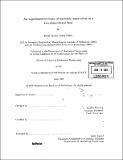| dc.contributor.advisor | Tomas Peacock and George Haller. | en_US |
| dc.contributor.author | Coral Pinto, Raul Javier | en_US |
| dc.contributor.other | Massachusetts Institute of Technology. Dept. of Mechanical Engineering. | en_US |
| dc.date.accessioned | 2006-07-31T15:30:07Z | |
| dc.date.available | 2006-07-31T15:30:07Z | |
| dc.date.copyright | 2005 | en_US |
| dc.date.issued | 2005 | en_US |
| dc.identifier.uri | http://hdl.handle.net/1721.1/33747 | |
| dc.description | Thesis (S.M.)--Massachusetts Institute of Technology, Dept. of Mechanical Engineering, 2005. | en_US |
| dc.description | Includes bibliographical references (leaves 102-104). | en_US |
| dc.description.abstract | An experimental study of flow separation in an incompressible two-dimensional unsteady flow was undertaken with the aim of validating recently developed flow separation criteria, which are based on kinematic principles. Specifically, the so-called rotor-oscillator arrangement was utilized to perform a series of experiments in steady, unsteady periodic, and aperiodic two- dimensional viscous flows at low Reynolds number. Flow separation under these conditions was investigated by means of flow visualization, shear stress sensors, and numerical simulation. The existence of fixed and moving separation structures, as predicted by the recent criteria, was verified in the experiments. Fixed separation structures were encountered in periodic flows and random flows, while moving separation was observed in a slow periodic flow and a random flow with linear drift. It was determined that separation in the rotor-oscillator experiment is strongly correlated to two factors: flow unsteadiness and flow ejection from the wall. The balance of the characteristic length and time scales of unsteadiness and ejection determines whether the separating structure is moving or is fixed. | en_US |
| dc.description.abstract | (cont.) The experimental and numerical results strengthen the notion that the instantaneous zero skin friction point alone does not denote flow separation in unsteady flow. Rather, flow separation in unsteady flow can be better understood from a Lagrangian perspective, in which case it can be treated in a robust and coherent manner. | en_US |
| dc.description.statementofresponsibility | by Raul Javier Coral Pinto. | en_US |
| dc.format.extent | 104 leaves | en_US |
| dc.format.extent | 6427232 bytes | |
| dc.format.extent | 6431552 bytes | |
| dc.format.mimetype | application/pdf | |
| dc.format.mimetype | application/pdf | |
| dc.language.iso | eng | en_US |
| dc.publisher | Massachusetts Institute of Technology | en_US |
| dc.rights | M.I.T. theses are protected by copyright. They may be viewed from this source for any purpose, but reproduction or distribution in any format is prohibited without written permission. See provided URL for inquiries about permission. | en_US |
| dc.rights.uri | http://dspace.mit.edu/handle/1721.1/7582 | |
| dc.subject | Mechanical Engineering. | en_US |
| dc.title | An experimental study of unsteady separation in a two-dimensional flow | en_US |
| dc.type | Thesis | en_US |
| dc.description.degree | S.M. | en_US |
| dc.contributor.department | Massachusetts Institute of Technology. Department of Mechanical Engineering | |
| dc.identifier.oclc | 65192739 | en_US |
